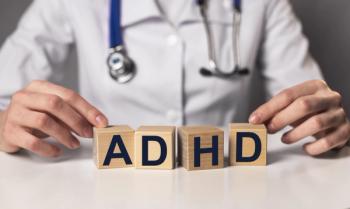
- Psychiatric Times Vol 23 No 9
- Volume 23
- Issue 9
ADHD in Girls: Wide Range of Negative Sequelae
Attention-deficit/hyperactivity disorder (ADHD) in girls may be more persistent than originally thought and may also be associated with a variety of behavioral and mental health consequences such as eating disorders, depression, and substance abuse.
Attention-deficit/hyperactivity disorder (ADHD) may conjure up the image of a restless, unfocused school boy. But the disease affects girls as well, and a recent study indicates that when it does, the disorder may persist and be associated with a variety of behavioral and mental health consequences. During adolescence, girls in whom ADHD was diagnosed in childhood were more likely to show symptoms of eating disorders, depression, and substance use disorders than a matched comparison group of girls without the neurobehavioral condition, according to the 5-year follow-up study.1
"For so long people thought girls really couldn't have ADHD, and if they did, it would be a transitory condition. We are finding that it is not transitory, it is persisting," said Stephen Hinshaw, PhD, chair of the department of psychology at the University of California, Berkeley, and lead author of the federally funded study.
Looking at more than 10 domains of functioning in the prospective follow-up study, the researchers found that the girls whose ADHD was diagnosed during childhood continued to show greater psychiatric symptomatology across multiple symptom areas (ADHD, externalizing, internalizing, eating, substance abuse, and dependence) as well as "larger functional impairments (global, social skills, peer relations, academic performance, self-perceptions, and service utilization rates) than did comparison girls."
Even though there was no comparison group of boys in their baseline and follow-up studies, Hinshaw said the researchers were able to look at national norms in follow-up studies of boys with ADHD. Comparisons revealed that girls with ADHD may actually have "a wider range of negative outcomes than boys."
"It is known that boys with ADHD as they grow up have a big risk for delinquency and school failure, and, depending upon the study, a medium to big risk for substance abuse," he added. "Our [adolescent] girl sample had a big risk for all of those."
In addition, the girls showed greater risk than boys for internalizing disorders, such as depression and anxiety symptoms, as well as for eating pathology and continued social rejection.
Childhood to adulthood
The recently published follow-up study is part of a series of studies examining whether girls with ADHD display continued symptomatology and impairment across the life span, Hinshaw said.
The first in the series was a childhood study published in 2002 that focused on 228 girls aged 6 to 12 years.2 Of that group, 140 had ADHD combined type (ADHD-C; n = 93) or inattentive type (ADHD-I; n = 47), and 88 were assigned to an age- and ethnicity-matched comparison group without the disorder. The sample was ethnically diverse (54% white, 27% African American, 11% Hispanic, 9% Asian American). The girls went through an 8-hour diagnostic workup and then attended a 5-week summer camp. Counselors and staff observing all the girls were not told which of the girls had ADHD.
Beyond the diagnostic workup, Hinshaw said that the researchers obtained information from multiple sources--parents, teachers, and peers--and by performing objective testing.
In the baseline study,2 the researchers found that girls with ADHD were more likely to show dysfunction than the comparison group of girls in terms of externalizing and internalizing behaviors, comorbidities, and cognitive and academic performance.
For the prospective follow-up study,1 the researchers were able to conduct evaluations on 209 of the original 228 participants (92%). The girls ranged in age from 11.3 to 18.2 years.
This August, Hinshaw noted, a 10-year follow-up study of the same girls began, funded by the National Institute of Mental Health.
"We are again going to be looking at a wide range of outcomes, not just ADHD and not just delinquency, but also depression, anxiety, and eating symptoms, and we are very interested in the kinds of relationships the girls end up getting into."
In the 10-year follow-up, Hinshaw expects to find more evidence of eating disorders and major depression. In the recent adolescent study,1 he explained, the girls did not have bona fide anorexia or bulimia, but rather symptoms of binging, purging, and dieting; but the symptoms occurred "a lot more in our ADHD than comparison sample. So we feel it [ADHD] puts them at risk for eating disorders."
Concerning depression, Hinshaw said, "The main measures we used were dimensional measures giving the symptoms of depression, and the girls with ADHD had many more symptoms of depression." About 30% of the girls with ADHD were at least mildly depressed, compared with 10% of the comparison group.1
"We think that by the time of our 10-year follow-up, when we do more adult-style psychiatric interviews, we may find higher risk for major depression," he added.
Analysis of subtypes
Because considerable debate exists about the distinctiveness of youth with ADHD-I as compared with those who have ADHD-C or ADHD hyperactive-impulsive type (ADHD-HI), the investigators in the follow-up prospective study hypothesized that, like boys, girls with ADHD would show a greater decline in HI symptoms than in inattentive symptoms from childhood. The research supported their hypothesis: HI symptoms were more likely to abate than inattentive symptoms.
At the 5-year follow-up,1 the data did not suggest major qualitative differences between the subtypes, Hinshaw added.
"The girls with the combined type were more likely to be aggressive and more likely to be rejected by their peers. Those are 2 significant outcomes. But in almost every single other instance--academic achievement, neuropsychological functioning, having friends, needing services, eating symptoms, depression--on average, girls in either the combined or the inattentive type had almost identical outcomes," he said.
Medication use
Asked about how medication use might influence the study results, Hinshaw said there was an attempt to assess medication use and to look at the girls' behaviors during medication-free periods.
In the initial baseline study,2 about 30% to 40% of the girls were taking medication, Hinshaw said. For those who were, the investigators didn't remove them from medication during the assessments, but they did ask teachers and parents to rate the girls during the period when they were not on medication. During the summer camp program, most of the families and physicians agreed that the girls could participate off medication for the 5 weeks. A few families who wanted their daughters on medication for some of the time agreed to have their daughters off medication for at least half of the summer camp.
At the 5-year follow-up,1 57% of the ADHD-C sample and 44% of the ADHD-I sample had been receiving psychotropic medications within the year before the follow-up assessments, although Hinshaw described the treatments as "relatively haphazard." Stimulant medications were being taken by 45% of the ADHD-C sample and 27% of the ADHD-I sample.
"Ethically, it gets difficult to take a girl off medication for long periods and then assess her. So what we did at the follow-up was if the girl was on stimulants, for some of the crucial measures we took the measures after a day stimulant-free, and we asked the parents and teachers once again to report on the girl when she was off medication," he said.
In the United States, an estimated 4.4 million children aged 4 to 17 years reportedly have a history of ADHD diagnosis, and of these, 2.5 million (57%) reportedly take medication for the disorder.3 The effect of medications is difficult to determine in a naturalistic study, Hinshaw said, but he knows from results of the Multimodal Treatment Study of Children with ADHD (MTA), in which he was a coinvestigator, that both medications and behavioral treatments are effective for ADHD.4
In the MTA, "medication had a stronger effect on average," he said, "but you got added benefit from combining medicine and behavioral treatment. We also know that once the 14 months of the MTA's very intensive treatment period ended, and everybody went to naturalistic treatment, the benefits faded. So . . . more intensive treatments need to be prolonged, rather than assuming that if you treat them as kids for a year or 2, everything will be fine afterwards. It is probably not the case."
Hinshaw suggested that physicians treating patients with ADHD carefully assess their medication, examine whether it is working, and determine at what dosage it works best. Also, he said, the medication needs to be combined with real work involving the family and school, teaching social skills to the girls in groups, and finding ways to motivate the family to stay with treatment over time.
"I'm not saying you can keep a family in twice-a-week treatment for years," he said, "families burn out and it's expensive, but it's a mistake to think that a short bout of treatment in childhood is going to persist in its gain."
Use of services
One of the goals of the follow-up study was to track how many school and community services the girls and their families used from baseline to follow-up. Only a very small percentage of girls in the comparison group were getting such school services as special education or tutoring, or such nonschool services as individual, group, or family therapy. In contrast, the study found that 70% to 80% of the ADHD-I and the ADHD-C groups were receiving services.
The difference reflects "how much need there is," he said, adding that he worried many of those services being provided are "somewhat transitory and somewhat fragmented."
Over the next year, Hinshaw said, the research group plans to publish more findings of the prospective follow-up study, looking at such issues as how adoption and child abuse may impact ADHD.
They also have a corollary study under review, in which they selected a subset of 10 girls with ADHD in the adolescent follow-up and 10 of the comparison girls and had them undergo brain scans. Hinshaw and his group were seeking to pinpoint the source of poor executive function skills, a common component of ADHD.
Greater understanding of ADHD in female populations, especially its longitudinal course, is a continuing research priority, Hinshaw said.
References:
References
1. Hinshaw SP, Owens EB, Sami N, Fargeon S. Prospective follow-up of girls with attention-deficit/hyperactivity disorder into adolescence: evidence for continuing cross-domain impairment. J Consult Clin Psychol. 2006; 74:489-499.
2. Hinshaw SP. Preadolescent girls with attention-deficit/hyperactivity disorder: I. Background characteristics, comorbidity, cognitive and social functioning, and parenting practices. J Consult Clin Psychol. 2002;70: 1086-1098.
3. Centers for Disease Control and Prevention (CDC). Mental Health in the United States. Prevalence of diagnosis and medication treatment for attention-deficit/hyperactivity disorder--United States, 2003. MMWR Weekly. 2005;54:842-847.
4. Jensen PS, Hinshaw SP, Swanson JM, et al. Findings from the NIMH Multimodal Treatment Study of ADHD (MTA): implications and applications for primary care providers. J Dev Behav Pediatr. 2001;22:60-73.
Articles in this issue
about 19 years ago
Psychotropic Drug Handbook, 8th Editionabout 19 years ago
Outcome of Medicare Fee Changes Uncertainabout 19 years ago
Depression Rates High in Young Women With Acute MIabout 19 years ago
New Legislative Move in Battle With Psychologistsabout 19 years ago
Principles and Practice of Geriatric Psychiatryabout 19 years ago
Stress Neurobiology and Corticotropin-Releasing Factorabout 19 years ago
End of Summerabout 19 years ago
Apathy and Depression in Parkinson Diseaseabout 19 years ago
Preventing Rehospitalization in Schizophreniaabout 19 years ago
Best Picture: How Far Will Hollywood Go?Newsletter
Receive trusted psychiatric news, expert analysis, and clinical insights — subscribe today to support your practice and your patients.














